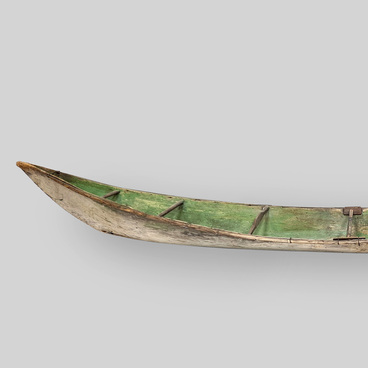The main occupations of the Forest Nenets are hunting, reindeer herding and fishing. From early childhood, Nenets boys learn to hunt, make traps, tame deer, and shoot from a bow. Every father makes a belt for his son as soon as the boy is five years old. A child wears a children’s belt until the age of 14, and then makes and begins to wear an adult men’s belt. This is a sign that the young man is becoming a real reindeer herder and hunter.
The belt is made of strong deer hide, which is impervious to weather. This is especially important during kaslaniye — traveling with a deer herd. The belt is decorated with copper plaques, steel pendants, buttons, a garland of bone buckles and mammoth tusk amulets. In the pocket of the belt, there is often a hidden bear’s fang, which has long been considered a symbol of good luck in hunting and a talisman against evil spirits. A wooden stick with notches is hung from the belt — this is a reindeer breeder’s notebook, in which he writes down the number of females, males and calves in the herd.
A men’s belt is not only a sign of distinction and a way to store hunting accessories, but also an important item of the national Nenets men’s clothing. It helps to shorten or lengthen the malitsa — a spacious shirt made of cloth or skins. When a strong wind blows in the tundra, the hunter loosens his belt, and the malitsa descends to its full length, covering the legs.
A Nenets man can rarely be seen without a belt. He removes the belt during meals and puts it next to him. The Nenets use a hunting knife as cutlery, a working tool and a weapon: to carve up a carcass, make sleds and tackle, and protect themselves from predators. The knife is always at hand — on the right side of the belt. It is suspended on leather straps or chains. The Nenets reindeer herder sits on the sled on the left, so the scabbard is safe during the ride: snow does not get inside, and they are hidden from blows and damage.
On the belt there is a place for a bag with a pipe and a steel. The Nenets used to wear a powder flask — a container for gunpowder, which was used in ramrod guns. The stone for sharpening the knife is stored in an elegant bag made of red cloth, decorated with beads, embroidery and deer fur.
The belt is made of strong deer hide, which is impervious to weather. This is especially important during kaslaniye — traveling with a deer herd. The belt is decorated with copper plaques, steel pendants, buttons, a garland of bone buckles and mammoth tusk amulets. In the pocket of the belt, there is often a hidden bear’s fang, which has long been considered a symbol of good luck in hunting and a talisman against evil spirits. A wooden stick with notches is hung from the belt — this is a reindeer breeder’s notebook, in which he writes down the number of females, males and calves in the herd.
A men’s belt is not only a sign of distinction and a way to store hunting accessories, but also an important item of the national Nenets men’s clothing. It helps to shorten or lengthen the malitsa — a spacious shirt made of cloth or skins. When a strong wind blows in the tundra, the hunter loosens his belt, and the malitsa descends to its full length, covering the legs.
A Nenets man can rarely be seen without a belt. He removes the belt during meals and puts it next to him. The Nenets use a hunting knife as cutlery, a working tool and a weapon: to carve up a carcass, make sleds and tackle, and protect themselves from predators. The knife is always at hand — on the right side of the belt. It is suspended on leather straps or chains. The Nenets reindeer herder sits on the sled on the left, so the scabbard is safe during the ride: snow does not get inside, and they are hidden from blows and damage.
On the belt there is a place for a bag with a pipe and a steel. The Nenets used to wear a powder flask — a container for gunpowder, which was used in ramrod guns. The stone for sharpening the knife is stored in an elegant bag made of red cloth, decorated with beads, embroidery and deer fur.


